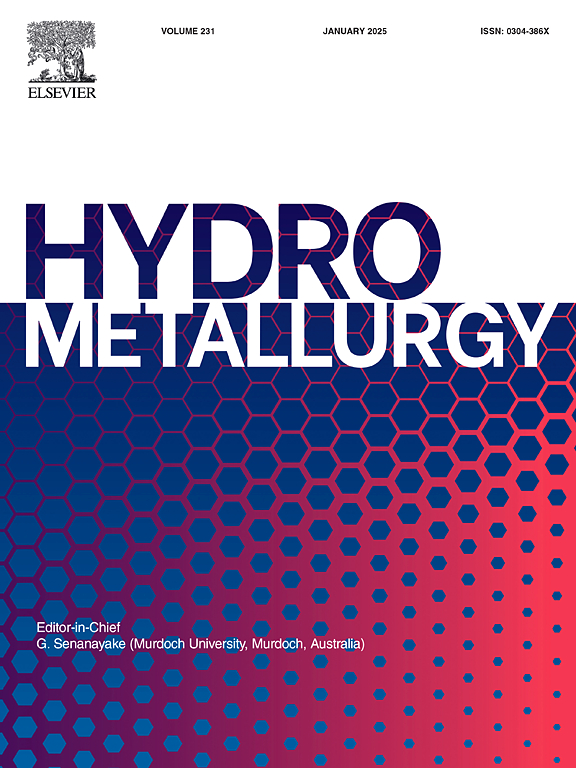使用羧酸基深共晶溶剂从电子废物中浸出金属:初步实验室研究和分子模型
IF 4.8
2区 材料科学
Q1 METALLURGY & METALLURGICAL ENGINEERING
引用次数: 0
摘要
本研究探索了深度共晶溶剂(DESs)的复杂化学性质,特别是那些与羧酸和氯化胆碱形成的溶剂,强调了它们在金属浸出中的有效性以及从电子废物中可持续回收有价值材料的潜力。在这种情况下,使用DESs显示了在处理电子废物方面推进生态友好方法的有希望的途径,有助于资源回收和环境管理。研究发现,特别是天然共晶溶剂,以乳酸为氢键供体,可以为传统的处理电子废物和回收具有战略意义的重要金属的方法提供绿色替代方案,这对于满足指数增长的电子产品生产的需求仍然至关重要。乳酸基DES (Lac-DES)在铜浸出方面比其他DES表现出更高的选择性,而草酸基DES (oxs -DES)在H2O2存在下似乎只选择性地浸出银(高达40%)。本文章由计算机程序翻译,如有差异,请以英文原文为准。

Leaching of metals from electronic waste using carboxylic acid-based deep eutectic solvents: Preliminary laboratory studies and molecular modelling
This research explores the intricate chemistry of deep eutectic solvents (DESs), particularly those formed with carboxylic acids and choline chloride, highlighting their effectiveness in metal leaching and the potential for sustainable recovery of valuable materials from electronic waste. The utilization of DESs in this context demonstrates a promising avenue for advancing eco-friendly methods in the treatment of electronic waste, contributing to both resource recovery and environmental management. It has been found that especially natural eutectic solvents, with lactic acid as the hydrogen bond donor, could provide a green alternative to conventional methods of processing electronic waste and recovery of strategically important metals, which remain crucial in order to meet the demand of the exponentially increasing electronics production. Lactic acid-based DES (Lac-DES) showed higher selectivity in Cu leaching over Ag, compared to other DESs, while oxalic acid-based DES (Ox-DES), surprisingly, appeared to leach selectively only silver (up to 40%) in the presence of H2O2.
求助全文
通过发布文献求助,成功后即可免费获取论文全文。
去求助
来源期刊

Hydrometallurgy
工程技术-冶金工程
CiteScore
9.50
自引率
6.40%
发文量
144
审稿时长
3.4 months
期刊介绍:
Hydrometallurgy aims to compile studies on novel processes, process design, chemistry, modelling, control, economics and interfaces between unit operations, and to provide a forum for discussions on case histories and operational difficulties.
Topics covered include: leaching of metal values by chemical reagents or bacterial action at ambient or elevated pressures and temperatures; separation of solids from leach liquors; removal of impurities and recovery of metal values by precipitation, ion exchange, solvent extraction, gaseous reduction, cementation, electro-winning and electro-refining; pre-treatment of ores by roasting or chemical treatments such as halogenation or reduction; recycling of reagents and treatment of effluents.
 求助内容:
求助内容: 应助结果提醒方式:
应助结果提醒方式:


